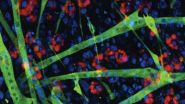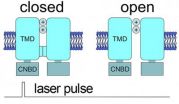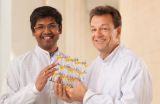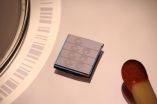(Press-News.org) LA JOLLA, Calif., April 11, 2014 — A team of scientists led by Pier Lorenzo Puri, M.D., associate professor at Sanford-Burnham Medical Research Institute (Sanford-Burnham), in collaboration with Fondazione Santa Lucia in Rome, Italy, have published details of how a class of drugs called "HDACis" drive muscle-cell regeneration in the early stages of dystrophic muscles, but fail to work in late stages. The findings are key to furthering clinical development of HDACis for Duchenne muscular dystrophy (DMD), an incurable muscle-wasting disease.
A symphony to rebuild muscle
The research, to be published April 15 in Genes and Development, used mouse models of DMD to show how fibro-adipogenic progenitor cells (FAPs) act like orchestra conductors in the music of muscle regeneration. FAPs sit in the space between muscle fibers and coordinate a complex symphony—receiving the notes that muscle has been damaged and directing muscle stem cells—satellite cells—to rebuild muscle.
"HDACis create an environment conducive for FAPs to direct muscle regeneration—but only during the early stages of DMD progression in mice," said Puri. "At some point, DMD progresses to a pathological point of no return and become permanently resistant to muscle-regeneration cures and to HDACis.
HDACis open the blueprints for muscle regeneration
HDACis stands for histone deacetylase inhibitors. They are epigenetic drugs that work by facilitating the accessibility to the genes that code for muscle proteins by the cell machinery that transcribes the genetic code into proteins. In essence, HDACis open the blueprints for protein manufacturing and instruct FAPs to support muscle regeneration.
In normal wear and tear, FAPs direct stem cells within the muscle to regenerate and repair damaged muscle. In DMD, the persistent breakdown of muscle cells creates an environment in such disarray that FAP's ability to direct muscle regeneration is compromised—like trying to conduct a symphony with punk rock music in the background.
Collaborating to find a treatment for DMD
Puri, along with his Italian colleagues at Fondazione Santa Lucia, Italfarmaco, and Parent Project Muscular Dystrophy, an advocacy association, are currently developing HDACis for the treatment of DMD – a clinical trial with DMD boys is currently ongoing.
"Our study is important because it provides the rational for the clinical development of HDACis to treat DMD," said Puri. "And, now that we understand the mechanics and sensitivities of the muscle-regeneration system, we have the rationale and can use new tools to select patients most likely to benefit from HDACIs based on their FAP profile, predict outcomes, and see how long patients should remain on the therapy."
"Duchenne muscular dystrophy patients and their families rely on important research such as that performed by Dr. Puri," said Debra Miller, Founder of Cure Duchenne, a patient advocacy group. "Our efforts at Cure Duchenne are to support leading scientists in the world to bring life-saving drugs to help this generation of Duchenne boys, and our vision is to cure Duchenne muscular dystrophy. Every added piece of knowledge about the disease brings us closer to realizing our goals."
INFORMATION:
Join the conversation about Duchenne muscular dystrophy by using the hash tag #Duchenne on Facebook and Twitter.
The study was co-authored by Valentina Saccone, Fondazione Santa Lucia, Istituto di Ricovero e cura a Caraterre Scientifico FSL, IRCCS; Silvia Consalvi, FSL, IRCCS; Lorenzo Giordani, Sanford-Burnham; Chiara Mozzetta, FSL, IRCCS; Iros Barozzi, European Institute of Oncology; Martina Sandona, FSL, IRCCS; Tammy Ryan, Sanford-Burnham; Agustin Rojas Munoz, Sanford-Burnham and UC San Diego; Luca Madaro, FSL, IRCCS and Sanford-Burnham; Pasquale Fasanaro, FSL, IRCCS; Giovanna Borsellino, FSL, IRCCS; Marco De Bardi, FSL, IRCCS; Gianmaria Frigè, European Institute of Oncology; Alberto Termanini, European Institute of Oncology; Zin Sun, The Hospital for Sick Children, and University of Toronto; Janet Rossant, The Hospital for Sick Children University of Toronto; Benoit Bruneau, Gladstone Institute of Cardiovascular Disease, and UC San Francisco; Marl Mercola, Sanford-Burnham and UC San Diego; Saverio Minucci, Insitute of Oncology, Milan, Italy, and University of Milan, Milan Italy.
The study was supported by the following grants: RO1 ARO56712, RO1ARO52779, P30 ARO61303 from NIH/National Institute of Arthritis and Musculoskelatal and Skin Diseases, EPIGEN, and the Muscular Dystrophy Association (MDA). This work benefited from research funding from the European Community's Seventh Framework Programme FP7-Health-2009 ENDOSTEM 241140.
About Duchenne
Duchenne muscular dystrophy is the most common fatal genetic disorder diagnosed in childhood, affecting approximately 1 in every 3,500 live male births (about 20,000 new cases each year). Because the Duchenne gene is found on the X chromosome, it primarily affects boys; however, it occurs across all races and cultures.
Duchenne results in progressive loss of strength and is caused by a mutation in the gene that encodes for dystrophin. Because dystrophin is absent, the muscle cells are easily damaged. The progressive muscle weakness leads to serious medical problems, particularly issues relating to the heart and lungs. Young men with Duchenne typically live into their late twenties.
About Sanford-Burnham Medical Research Institute
Sanford-Burnham Medical Research Institute is dedicated to discovering the fundamental molecular causes of disease and devising the innovative therapies of tomorrow. Sanford-Burnham takes a collaborative approach to medical research with major programs in cancer, neurodegeneration and stem cells, diabetes, and infectious, inflammatory, and childhood diseases. The Institute is recognized for its National Cancer Institute-designated Cancer Center and expertise in drug discovery technologies. Sanford-Burnham is a nonprofit, independent institute that employs 1,200 scientists and staff in San Diego (La Jolla), Calif., and Orlando (Lake Nona), Fla. For more information, visit us at sanfordburnham.org.
Sanford-Burnham can also be found on Facebook at facebook.com/sanfordburnham as well as on Twitter @sanfordburnham.
Regenerating muscle in Duchenne muscular dystrophy: Age matters
Researchers reveal novel cellular and molecular elements of muscle repair. The study explains how drugs can induce regeneration, while preventing fibrosis and fat deposition, in dystrophic muscle at early stages of Duchenne muscular dystrophy
2014-04-14
ELSE PRESS RELEASES FROM THIS DATE:
New 'tunable' semiconductors will allow better detectors, solar cells
2014-04-14
One of the great problems in physics is the detection of electromagnetic radiation – that is, light – which lies outside the small range of wavelengths that the human eye can see. Think X-rays, for example, or radio waves.
Now, researchers have discovered a way to use existing semiconductors to detect a far wider range of light than is now possible, well into the infrared range. The team hopes to use the technology in detectors, obviously, but also in improved solar cells that could absorb infrared light as well as the sun's visible rays.
"This technology will also ...
A stable model for an unstable target
2014-04-14
A study in The Journal of General Physiology provides new insights about singlet oxygen and sets the stage for better understanding of this highly reactive and challenging substance.
Singlet oxygen is an electronically excited state of oxygen that is less stable than normal oxygen. Its high reactivity has enabled its use in photodynamic therapy, in which light is used in combination with a photosensitizing drug to generate large amounts of singlet oxygen to kill cancer cells or various pathogens.
Light-generated singlet oxygen also plays a role in a range of biological ...
Better solar cells, better LED light and vast optical possibilities
2014-04-14
Changes at the atom level in nanowires offer vast possibilities for improvement of solar cells and LED light. NTNU-researchers have discovered that by tuning a small strain on single nanowires they can become more effective in LEDs and solar cells.
NTNU researchers Dheeraj Dasa and Helge Weman have, in cooperation with IBM, discovered that gallium arsenide can be tuned with a small strain to function efficiently as a single light-emitting diode or a photodetector. This is facilitated by the special hexagonal crystal structure, referred to as wurtzite, which the NTNU ...
Pioneering findings on the dual role of carbon dioxide in photosynthesis
2014-04-14
Scientists at Umeå University in Sweden have found that carbon dioxide, in its ionic form bicarbonate, has a regulating function in the splitting of water in photosynthesis. This means that carbon dioxide has an additional role to being reduced to sugar. The pioneering work is published in the latest issue of the scientific journal PNAS.
It is well known that inorganic carbon in the form of carbon dioxide, CO2, is reduced in a light driven process known as photosynthesis to organic compounds in the chloroplasts. Less well known is that inorganic carbon also affects the ...
The result of slow degradation
2014-04-14
This news release is available in German. Although persistent environmental pollutants have been and continue to be released worldwide, the Arctic and Antarctic regions are significantly more contaminated than elsewhere. The marine animals living there have some of the highest levels of persistent organic pollutant (POP) contamination of any creatures. The Inuit people of the Arctic, who rely on a diet of fish, seals and whales, have also been shown to have higher POP concentrations than people living in our latitudes.
Today, the production and use of nearly two dozen ...
Nutrient-rich forests absorb more carbon
2014-04-14
The ability of forests to sequester carbon from the atmosphere depends on nutrients available in the forest soils, shows new research from an international team of researchers including the International Institute for Applied Systems Analysis (IIASA).
The study showed that forests growing in fertile soils with ample nutrients are able to sequester about 30% of the carbon that they take up during photosynthesis. In contrast, forests growing in nutrient-poor soils may retain only 6% of that carbon. The rest is returned to the atmosphere as respiration.
"This paper produces ...
Scientists open door to better solar cells, superconductors and hard-drives
2014-04-14
Using DESY's bright research light sources, scientists have opened a new door to better solar cells, novel superconductors and smaller hard-drives. The research reported in the scientific journal Nature Communications this week enhances the understanding of the interface of two materials, where completely new properties can arise. With their work, the team of Prof. Andrivo Rusydi from the National University of Singapore and Prof. Michael Rübhausen from the Hamburg Center for Free-Electron Laser Science (CFEL) have solved a long standing mystery in the physics of condensed ...
Combs of light accelerate communication
2014-04-14
This news release is available in German.
Miniaturized optical frequency comb sources allow for transmission of data streams of several terabits per second over hundreds of kilometers – this has now been demonstrated by researchers of Karlsruhe Institute of Technology (KIT) and the Swiss École Polytechnique Fédérale de Lausanne (EPFL) in a experiment presented in the journal Nature Photonics. The results may contribute to accelerating data transmission in large computing centers and worldwide communication networks. (DOI: 10.1038/NPHOTON.2014.57.)
The amount of ...
Proteomics International biomarker study closer to a CDx test for diabetic kidney disease
2014-04-14
April 2014, Perth, Australia. Drug discovery company Proteomics International has completed an important milestone towards the development of a companion diagnostic (CDx) test with the validation of several of its protein biomarkers.
The research team authenticated the panel of biomarkers after taking 508 highly curated disease and control samples. Seven biomarkers were validated at high stringency using the company's proprietary mass spectrometry approach.
The mass spectrometry data was then cross-validated using immunoassays in collaboration with the KTH Royal Institute ...
Beneficial organisms react differently to parasite drug
2014-04-14
The substance ivermectin has been used for more than thirty years all over the world to combat parasites like roundworms, lice and mites in humans, livestock and pets. The active ingredient belongs to the chemical group of avermectins, which generally disrupt cell transport and thus attack pests. When ivermectin is excreted in the faeces of treated animals, at overly high doses it also harms dung-degrading beneficial insects like dung beetles and dung flies. This impairs the functioning of the ecosystem. In extreme cases the dung is not decomposed and the pasture is destroyed.
Sensitivity ...
LAST 30 PRESS RELEASES:
The Ceramic Society of Japan’s Oxoate Ceramics Research Association launches new international book project
Heart-brain connection: international study reveals the role of the vagus nerve in keeping the heart young
Researchers identify Rb1 as a predictive biomarker for a new therapeutic strategy in some breast cancers
Survey reveals ethical gaps slowing AI adoption in pediatric surgery
Stimulant ADHD medications work differently than thought
AI overestimates how smart people are, according to HSE economists
HSE researchers create genome-wide map of quadruplexes
Scientists boost cell "powerhouses" to burn more calories
Automatic label checking: The missing step in making reliable medical AI
Low daily alcohol intake linked to 50% heightened mouth cancer risk in India
American Meteorological Society announces Rick Spinrad as 2026 President-Elect
Biomass-based carbon capture spotlighted in newly released global climate webinar recording
Illuminating invisible nano pollutants: advanced bioimaging tracks the full journey of emerging nanoscale contaminants in living systems
How does age affect recovery from spinal cord injury?
Novel AI tool offers prognosis for patients with head and neck cancer
Fathers’ microplastic exposure tied to their children’s metabolic problems
Research validates laboratory model for studying high-grade serous ovarian cancer
SIR 2026 delivers transformative breakthroughs in minimally invasive medicine to improve patient care
Stem Cell Reports most downloaded papers of 2025 highlight the breadth and impact of stem cell research
Oxford-led study estimates NHS spends around 3% of its primary and secondary care budget on the health impacts of heat and cold in England
A researcher’s long quest leads to a smart composite breakthrough
Urban wild bees act as “microbial sensors” of city health.
New study finds where you live affects recovery after a hip fracture
Forecasting the impact of fully automated vehicle adoption on US road traffic injuries
Alcohol-related hospitalizations from 2016 to 2022
Semaglutide and hospitalizations in patients with obesity and established cardiovascular disease
Researchers ‘listen in’ to embryo-mother interactions during implantation using a culture system replicating the womb lining
How changing your diet could help save the world
How to make AI truly scalable and reliable for real-time traffic assignment?
Beyond fragmented markets: A new framework for efficient and stable ride-pooling
[Press-News.org] Regenerating muscle in Duchenne muscular dystrophy: Age mattersResearchers reveal novel cellular and molecular elements of muscle repair. The study explains how drugs can induce regeneration, while preventing fibrosis and fat deposition, in dystrophic muscle at early stages of Duchenne muscular dystrophy



